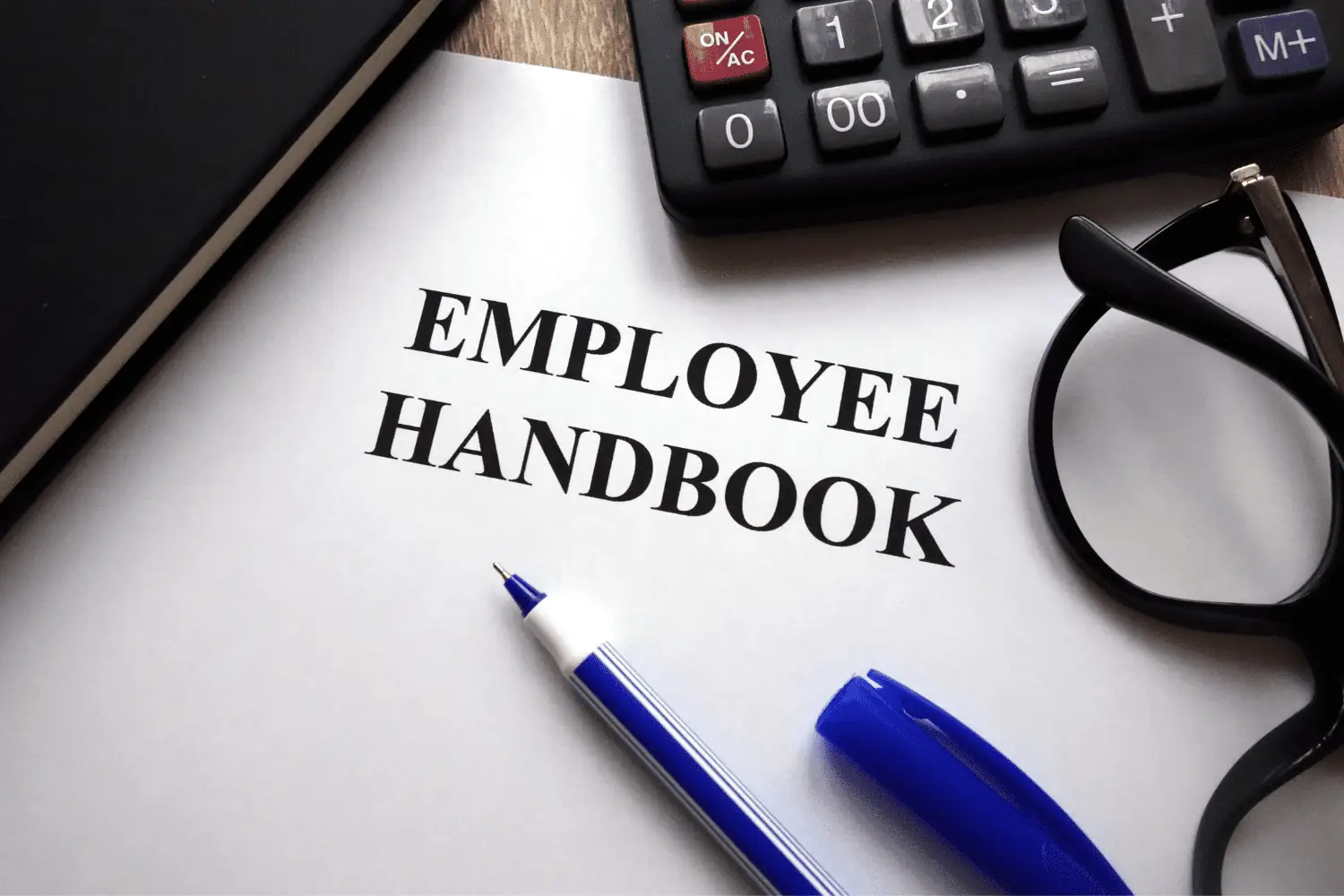8 Tips for Creating an Employee Handbook as an Employer

An employee handbook is sometimes mistakenly viewed as antiquated and unnecessary. Companies may even assume employees won’t read it. They use sample handbooks that haven’t been updated in years, leave policies that are not in compliance with current laws, or create employee handbooks that are missing legally required policies and rules. These kinds of employee handbooks may give an employer more trouble than they prevent. A comprehensive, updated employee handbook has many benefits. Some benefits include that it reduces risk by keeping employment practices within relevant laws, it ensures fair and equal treatment for all employees, its policies encourage better performance from employees, it builds the kind of culture employees want to join and stay, it reduces any confusion about rules and policies, and it will give a manager guidance on responding to difficult situations. These are nine best practices for creating employee handbook policies that give benefits to both employees and the employer.

1. Write policies for compensation and benefits.
Write policies that detail how employees will get paid, receive benefits, accrue vacation time, get bonuses or get commissions. These policies could also detail how employees who want raises should ask for them or if they will be paid out on a yearly basis regardless.
2. Keep the employee handbook updated every year.
When a company chooses to create an employee handbook (or handbooks), it’s imperative that they keep it updated. If a business doesn’t update its employee handbook on a yearly basis, the handbook may run afoul of state or federal employment laws. It may also not be compliant with laws based on the size of the company. If the business grew or shrank, it may now be subject to different laws because of the number of employees. The last reason that a business may want to update its employee handbook is to keep it consistent with corporate culture. A company may want to create a more inclusive company culture. This could trigger a need for an employee handbook with policies that require employees to be more tolerant and supportive of employees who are of a different class, gender, religion, culture, age group, etc. The employee handbook may include policies for reporting harassment by another company member, sharing pronouns, or how to participate in diversity committees and initiatives.
3. Ensure company policy is always in compliance with all relevant laws.
A company must ensure that their employee handbook is in compliance with federal and state employment laws. If a company has multiple business locations, or if they have employees who work remotely in another state, they may be subject to a larger set of laws. A best practice for handling this circumstance is for a company to create a different employee handbook for each location or to create an addendum for a different state. It may help to have HR professionals, like the ones at MP, or an employment lawyer with knowledge of state laws, to review the employee handbook. They will be up to date with any new employment laws that have been passed or changed on the state or federal level.
4. Include all required policies in the employee handbook.
While a business isn’t required by any laws to create an employee handbook, they must include certain policies for employees if they do create handbooks. Required employee handbook policies will vary from state to state. However, any employee handbook created by a company must have an at-will disclaimer for employees. These kinds of handbook policies reflect the laws surrounding disintegrating a relationship between employees and their employers. Depending on the industry of the company, they may have required employment policies with safety rules for employees, too.

5. Share an updated handbook the right way.
To maintain compliance with employment laws, it’s not enough for a company to create an employee handbook or update their existing handbook. A company must share its employee handbook in a way that isn’t only temporarily accessible to employees. The employee handbook would ideally be shared with employees on a bulletin board for employees, on the company intranet, via an electronic copy that can be downloaded and read if employees want, or possibly via a combination of these methods. (MP’s HR software makes it easy to build an employee handbook and share it with employees electronically.)
6. Develop or update a telework policy for your employee handbook.
Employers should create policies for employees to follow when working remotely. Employers who switch to a remote or hybrid work environment post-pandemic may not have clear or comprehensive telework policies in place. Especially if employees will be working remotely more frequently than before the pandemic, this kind of employee policy will be vital for success and protecting the organization. (Note that MP’s HR consulting team will assist with developing a solid telework policy.) An employer will also want to create telework policies to ensure that there are never any issues with miscommunications, meetings, employees delivering work, or misuse of technology by employees. A clear telework policy will reduce or eliminate surprises and miscommunications. Telework policies clearly state what kinds of tasks employees can perform remotely and what must be done in the office. Otherwise, employers have less standing to reject requests from employees who want to work remotely, but aren’t permitted to do so. Comprehensive telework policies must include expectations for:
- How employees will deliver work
- How employees will respond to questions
- How employees and managers will meet
- How employees will document their hours worked
- How managers will give employees feedback
- When employees will be expected to work or be available to coworkers, managers or clients
7. Get a disaster contingency policy.
Every business will benefit when they create policies for disasters in their employee handbook. A company usually doesn’t consider what they will want employees to do in the event of disaster until one is happening. Having policies in the employee handbook will ensure that a company reduces legal risk and improves the safety of employees. When created, these kinds of policies should include:
- Who will be the company point of contact in an emergency
- How company communications will be shared if there is an emergency
- What alternative steps employees should take if there is an issue in the place of business
- The rules for safely and quickly evacuating the place of business
8. Manage consistently to the employee handbook.
The most critical part of updating an employee handbook and its policies is ensuring that managers are trained in its rules and they implement them as they manage employees. It’s important to note that managers must consistently apply the rules of the handbook in managing employees. If the rules of the employee handbook are applied to some employees but not others, or a manager decides to give a pass on certain policies to their favorite employees (but not other employees), there may be complaints about discrimination. Employees may even want to sue the company for discrimination if they feel the company is applying the rules of the employee handbook in an inconsistent manner. Successful discrimination lawsuits brought by employees are usually based on laws surrounding protections for race, gender, religion, gender expression, if employees are pregnant, etc. In addition to training managers in the employee handbook, it will also be important from an employment laws perspective to train managers on discrimination.
Recent Handbook Posts
Recent Posts
- Building a High-Impact Leadership Development Strategy: A Step-by-Step Guide
- Why Leadership Training Matters in 2025 and Beyond
- The Real Reason Your New Hires Quit (And How to Fix It with Smarter Onboarding) – Zip Drive INCLUDED
- Learn & Grow: The Learning Management System for Employee Engagement and Retention
- From Attic to Innovation: Jason Maxwell’s HR Leadership Journey
Categories
- ACA (10)
- AI (6)
- BizFeed (6)
- Business Strategy (119)
- COBRA (5)
- Compliance (202)
- COVID-19 (92)
- Diversity (12)
- eBooks (19)
- Employee Engagement (33)
- Employee Handbooks (24)
- ERTC (29)
- FFCRA (7)
- HR (306)
- MP Insider (13)
- Payroll (122)
- PFML (9)
- PPP (24)
- PTO (5)
- Recruiting (53)
- Remote Work (39)
- Return to Work (32)
- Unemployment (1)
- Wellness (22)
Archives
- May 2025
- April 2025
- March 2025
- February 2025
- January 2025
- December 2024
- November 2024
- October 2024
- September 2024
- August 2024
- July 2024
- June 2024
- May 2024
- April 2024
- March 2024
- February 2024
- January 2024
- December 2023
- November 2023
- October 2023
- July 2023
- June 2023
- May 2023
- April 2023
- March 2023
- January 2023
- December 2022
- October 2022
- September 2022
- August 2022
- July 2022
- June 2022
- May 2022
- April 2022
- March 2022
- February 2022
- January 2022
- December 2021
- November 2021
- October 2021
- September 2021
- August 2021
- July 2021
- June 2021
- May 2021
- April 2021
- March 2021
- February 2021
- January 2021
- December 2020
- November 2020
- October 2020
- September 2020
- August 2020
- July 2020
- June 2020
- May 2020
- April 2020
- March 2020



